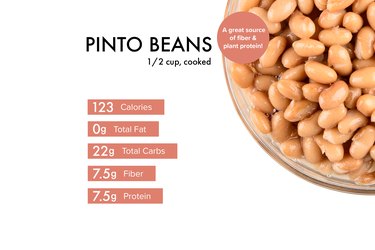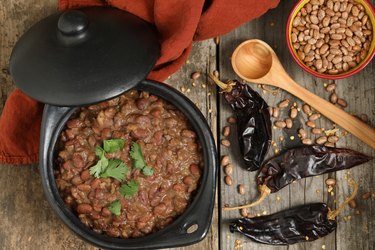
If you've had refried beans before then you've had pinto beans. Not only are they a staple in Mexican and South American cooking, but their popularity in southern cooking also can't be understated.
Pinto beans are in a class of plant foods called pulses, which are edible seeds grown in a pod — pulses also include lentils, peas and soybeans. Pinto beans are tan, medium-sized beans with beautiful flecks of brown.
Video of the Day
Video of the Day
You can find pinto beans dried in a bag, but if cooking those is a little too intimidating, you can grab canned beans instead (just remember to choose the brand with the lowest sodium content or rinse the beans to remove some of the sodium). Either way, you are about to find your new favorite bean.
Pinto Beans Nutrition Facts
One serving of pinto beans is a half cup of cooked beans. A half-cup of cooked pinto beans without salt contains:
- Calories: 123
- Total fat: 0 g
- Cholesterol: 0 mg
- Sodium: 0 mg
- Total carbs: 22 g
- Dietary fiber: 7.5 g
- Sugar: 0 g
- Added sugar: 0 g
- Protein: 7.5 g
Pinto Beans Macros
- Total fat: A half-cup serving of pinto beans contains less than 1 gram of fat.
- Carbohydrates: A half-cup serving of cooked pinto beans contains 22 grams of carbohydrates, with 7.5 grams of fiber and 0 grams of sugar.
- Protein: A half-cup serving of pinto beans has 7.5 grams of plant-based protein.
Do Pinto Beans Contain Good Carbs?
Most of the carbs in pinto beans come from fiber and starch, which can help you feel full for longer. Pinto beans are less likely to spike your blood sugar and along with a healthy diet, eating beans regularly and in moderation can help control your weight.
Vitamins, Minerals and Other Nutrients
- Folate: 37% Daily Value (DV)
- Phosphorus: 10% DV
- Potassium: 8% DV
- Magnesium: 10% DV
- Iron: 10% DV
- One serving of pinto beans is not a significant source of calcium (3% DV) vitamin C (1% DV), vitamin A (0%DV), vitamin B12 (0% DV) or vitamin E (5% DV).
Are Pinto Beans Better for You Than Other Beans?
Pinto Beans vs. Other Beans
Pinto Beans | |||||
Calories | 123 | 113 | 113 | 128 | 133 |
Fat | 0 g | 0 g | 0 g | 0.5 g | 0 g |
Carbohydrates | 22 g | 20 g | 20 g | 24 g | 25 g |
Fiber | 7.5 g | 7.5 g | 5.5 g | 9.5 g | 4.5 g |
Protein | 7.5 g | 7.5 g | 7.5 g | 7.5 g | 8 g |
Health Benefits of Pinto Beans
Pinto beans are naturally gluten-free and provide a number of health benefits.
1. They're Linked to Lowering Blood Pressure
If you have high blood pressure, adding beans to an overall healthy diet may help you reduce your numbers. Those who replace pulses in their diet for other foods were observed to lower their systolic blood pressure by 2.25mm Hg, according to a January 2014 review published in the American Journal of Hypertension.
Pinto beans also pack 8 percent of your daily value of potassium, a mineral that helps to pull sodium out of the body, which can help lower your blood pressure, according to the American Heart Association.
2. Pinto Beans Are Associated With Lower Cholesterol Levels
Pinto beans contain soluble fiber, the type of fiber that binds to cholesterol and pulls it out of your body before it gets a chance to swim around in your blood, according to Harvard Health Publishing.
Having high levels of LDL cholesterol, which is the harmful type of cholesterol, is a contributor to atherosclerosis and heart disease. Eating just 5 to 10 grams of soluble fiber each day can help you lower your LDL cholesterol, according to the Mayo Clinic.
3. They Might Help Ease Digestive Woes
Eating a diet rich in fiber can help alleviate constipation, per the National Institutes of Health. Pinto beans are a good source of fiber, and while experts don't know exactly what causes constipation in each and every person, looking at the diet is a great place to start.
Regularly adding fiber-rich foods such as pinto beans to your plate will naturally increase the amount of fiber in your diet to help you reach the recommended daily amount of 25 grams of women and 38 grams for men.
4. Pinto Beans Are Linked to a Reduced Risk of Type 2 Diabetes
Pinto beans are low on the glycemic index (GI) scale, which is a measure of how much a food raises your blood sugar. Because of that, beans can help control your blood sugar.
Legumes, in general, were associated with reducing the risk for developing diabetes and helping control your diabetes if you already have it, according to May 2017 research published in Clinical Nutrition.
Health Risks of Pinto Beans
Gastrointestinal Discomfort
The biggest concern with eating more beans is the drastic increase in fiber, especially if you are eating more than one serving. Eating more fiber than you usually do can cause gas, bloating and cramps.
While excess gas isn't a health risk, you shouldn't let this embarrassing side effect deter you from eating beans.
Tips for Preventing Gas From Beans
- Soaking your beans before cooking them can reduce the flatulence-causing oligosaccharide content by 76 percent, per May 2014 research in the American Journal of Clinical Nutrition.
- Try increasing your fiber and pinto bean intake gradually to avoid the uncomfortable side effects and drink plenty of water to help all that fiber move easily through your digestive system.
Drug Interactions
Pinto beans are not known to have any interactions with medications, but if it worries you, have a conversation with your doctor about your diet and current medications.

How to Cook Pinto Beans
If you're opting for dry beans instead of canned variety (which are already cooked), try using one of these three different soaking methods, North Dakota State University recommends.
Two cups of dry beans will yield approximately 6 cups of cooked beans.
3 Methods for Cooking Dry Pinto Beans
Traditional | Hot Soak | Quick Soak | |
Step 1 | Place beans in a large bowl and cover with water. | Add 2 cups of beans and 10 cups of water to a large pot. | Add 2 cups of beans and 2 cups of water to a pot. |
Step 2 | Soak 8+ hours. | Boil for 2 minutes, then remove from heat, cover and leave alone for 24 hours. | Boil for 2 minutes, then remove from heat, cover and leave alone for 1 hour |
Step 3 | Drain beans, throw away soaking water and rinse beans. | Drain beans, throw away soaking water and rinse beans. | Drain beans, throw away soaking water and rinse beans. |
Cook (total cooking time: 90 to120 minutes) | Cover beans with water and bring to a boil; reduce heat to a simmer until beans are tender, adding more water if necessary to keep a simmer. | Cover beans with water and bring to a boil; reduce heat to a simmer until beans are tender, adding more water if necessary to keep a simmer. | Cover beans with water and bring to a boil; reduce heat to a simmer until beans are tender, adding more water if necessary to keep a simmer. |
Pinto Bean Preparation and Useful Tips
Before cooking dried beans or enjoying canned beans, look to these useful tips.
- Discard the soaking water and start with fresh cold water to cook your beans.
- Wait until the end of the cooking process to add flavors containing acid, such as lemon juice or ketchup.
- Always rinse your canned beans to remove excess sodium.
Pinto beans can be subbed in and out of recipes effortlessly for when you find yourself without a particular type of bean in the pantry.
- Substitute black beans for use in refried beans.
- Substitute kidney beans for chili recipes that call for pinto beans.
- Use pinto beans instead of navy beans for baked bean recipes.
- Pinto beans can be used in place of chickpeas for a hearty hummus.
- Use pinto beans to add bulk to ground beef, chicken or turkey to make your meat go further.
Recipes With Pinto Beans
Alternatives to Pinto Beans
Legumes are all great sources of plant protein and fiber, a combo that will help keep you satiated. Any type of legume can sub for pinto beans, including the following:
- Kidney beans
- Black beans
- Navy beans
- Pink beans
- Lima beans
- Great Northern beans
- Chickpeas
- Lentils
- USDA: "Black Beans"
- American Journal of Hypertension: "Effect of Dietary Pulses on Blood Pressure: A Systematic Review and Meta-analysis of Controlled Feeding Trials"
- American Heart Association: "How Potassium Can Help Control High Blood Pressure
- Harvard Medical School: "11 Foods That Lower Cholesterol"
- National Institutes of Health: "Concerned About Constipation?"
- North Dakota State University: "All About Beans Nutrition, Health Benefits, Preparation and Use in Menus"
- American Journal of Clinical Nutrition: "Nutrition and Health Benefits of Dried Beans"
- Clinical Nutrition: "Legume Consumption is Inversely Associated With Type 2 Diabetes Incidence in Adults: A Prospective Assessment From the PREDIMED Study"
- USDA: "Kidney Beans"
- USDA: "Navy Beans"
- USDA: "Pink Beans"
- Mayo Clinic: "Cholesterol: Top Foods to Improve your Numbers"
- USDA: "Pinto Beans"